Mercedes-Benz W113
The Mercedes-Benz W 113 is a two-seat roadster/coupé, introduced at the 1963 Geneva Motor Show, and produced from 1963 through 1971. It replaced both the 300 SL (W 198) and the 190 SL (W 121 BII). Of the 48,912 W 113 SLs produced, 19,440 were sold in the US.
| Mercedes-Benz W113 230 SL, 250 SL, 280 SL | |
|---|---|
.jpg.webp) | |
| Overview | |
| Manufacturer | Mercedes-Benz |
| Production | 1963–1971 48,912 built[1] |
| Assembly | West Germany: Stuttgart Sindelfingen |
| Designer | Friedrich Geiger Béla Barényi Paul Bracq |
| Body and chassis | |
| Class | Sports car / Grand tourer |
| Body style | 2-door coupé 2-door roadster |
| Layout | FR layout |
| Platform | Mercedes-Benz W111 |
| Related | Mercedes-Benz W108 Mercedes-Benz W109 Mercedes-Benz W112 |
| Powertrain | |
| Engine | 2,308 cc (2.3 L) M127.II SOHC I6 2,496 cc (2.5 L) M129.II SOHC I6 2,778 cc (2.8 L) M130 SOHC I6 |
| Transmission | 4-speed automatic 4-speed manual 5-speed ZF S5-20 manual |
| Dimensions | |
| Wheelbase | 2,400 mm (94.5 in) |
| Length | 4,335 mm (170.7 in) |
| Width | 1,760 mm (69.3 in) |
| Height | 1,305 mm (51.4 in) |
| Curb weight | 1,300 kg (2,866 lb) |
| Chronology | |
| Predecessor | Mercedes-Benz W198 Mercedes-Benz W121 BII |
| Successor | Mercedes-Benz R107 |
- See Mercedes-Benz SL-Class for a complete overview of all SL-Class models.
The W 113 SL was developed under the auspices of Mercedes-Benz Technical Director Fritz Nallinger, Chief Engineer Rudolf Uhlenhaut and Head of Styling Friedrich Geiger. The lead designers were Paul Bracq and Béla Barényi, who created its patented,[2] slightly concave hardtop, which inspired the "Pagoda" nickname.
All models were equipped with an inline-six cylinder engine with multi-port fuel injection. The bonnet, boot lid, door skins and tonneau cover were made of aluminum to reduce weight. The comparatively short and wide chassis, combined with an excellent suspension, powerful brakes and radial tires gave the W 113 superb handling for its time. The styling of the front, with its characteristic upright Bosch "fishbowl" headlights and simple chrome grille, dominated by the large three-pointed star in the nose panel, paid homage to the 300 SL roadster.
W 113 SLs were typically configured as a "Coupe/Roadster" with a soft-top and an optional removable hardtop. A 2+2 was introduced with the 250 SL "California Coupe," which had a fold-down rear bench seat instead of the soft-top.
History
By 1955, Mercedes-Benz Technical Director Prof. Fritz Nallinger and his team held no illusions regarding the 190 SL's lack of performance, while the high price tag of the legendary 300 SL supercar kept it elusive for all but the most affluent buyers. Thus Mercedes-Benz started evolving the 190 SL on a new platform, model code W127, with a fuel-injected 2.2 liter M127 inline-six engine, internally denoted as 220SL. Encouraged by positive test results, Nallinger proposed that the 220SL be placed in the Mercedes-Benz program, with production commencing in July 1957.
However, while technical difficulties kept postponing the production start of the W127, the emerging new S-Class W 112 platform introduced novel body manufacturing technology altogether. So in 1960, Nallinger eventually proposed to develop a completely new 220SL design, based on the "fintail" W 111 sedan platform with its chassis shortened by 30 cm (11.8 in), and technology from the W 112. This led to the W 113 platform, with an improved fuel-injected 2.3 liter M127 inline-six engine and the distinctive "pagoda" hardtop roof, designated as 230 SL.[3]
The 230 SL made its debut at the Geneva Motor Show in March 1963, where Nallinger introduced it as follows: "It was our aim to create a very safe and fast sports car with high performance, which despite its sports characteristics, provides a very high degree of traveling comfort".[4]
Designed-in safety
The W 113 was the first sports car with a "safety body," based on Bela Barényi's extensive work on vehicle safety: It had a rigid passenger cell and designated crumple zones with impact-absorbing front and rear sections built into the vehicle structure. The interior was "rounded," with all hard corners and edges removed, as in the W 111 sedan.
The W 113 was also the first Mercedes-Benz with radial tires.
Models
230 SL (1963-1967)
.jpg.webp)
Production of the 230 SL commenced in June 1963 and ended on 5 January 1967. Its chassis was based on the W 111 sedan platform, with a reduced wheelbase by 30 cm (11.8 in), recirculating ball steering (with optional power steering), double wishbone front suspension and an independent single-joint, low-pivot swing rear-axle with transverse compensator spring. The dual-circuit brake system had front disc brakes and power-assisted rear drum brakes.[5] The 230 SL was offered with a 4-speed manual transmission, or an optional, very responsive fluid coupled (no torque converter) 4-speed automatic transmission, which was popular for US models. From May 1966, the ZF S5-20 5-speed manual transmission was available as an additional option, which was particularly popular in Italy. Of the 19,831 230 SLs produced, less than a quarter were sold in the US.
The 2,308 cc (2.3 L) M127.II inline-six engine with 150 PS (110 kW; 148 hp) and 196 N⋅m (145 lb⋅ft) torque was based on Mercedes-Benz' venerable M180 inline-six with four main bearings and mechanical Bosch multi-port fuel injection. Mercedes-Benz made a number of modifications to boost its power, including increasing displacement from 2,197 cc (2.2 L), and using a completely new cylinder head with a higher compression ratio (9.3 vs. 8.7), enlarged valves and a modified camshaft. A fuel injection pump with six plungers instead of two was fitted, which allowed placing the nozzles in the cylinder head and "shooting" the fuel through the intake manifold and open valves directly into the combustion chambers.[6] An optional oil-water heat exchanger was also available.
Mercedes-Benz Chief Engineer Rudolf Uhlenhaut demonstrated the capabilities of the 230 SL on the tight three-quarter mile Annemasse Vétraz-Monthoux race track in 1963, where he put up a best lap time of 47.5 seconds vs. 47.3 seconds by Grand Prix driver Mike Parkes on his 3-liter V12 Ferrari 250 GT.[7]
A brief chronology of the most notable changes made to the 230 SL:[8]
- 10/1963: First 230 SL with automatic transmission.
- 09/1964: Spare tire well removed, tire mounted horizontally.
- 11/1964: Optional tinted/thermal glass and new soft-top with steel bows (distinguished by missing chrome trim on the outer trailing edge).[9]
- 04/1964: US models with radio Becker Europa TR instead of Europa TG.
- 08/1965: Some harmonization with new W 108/W 109 sedans, incl. new floor panels, combined brake and clutch fluid reservoir, boot light and interior changes. US models with hazard lights.
- 03/1966: Mounts for three-point seat belts added.
- 05/1966: Optional ZF 5-speed manual transmission; rare and now very desirable.
250 SL (1966–1968)
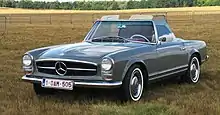
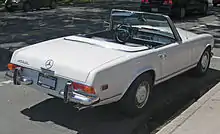
The 250 SL was introduced at the 1967 Geneva Motor Show.[10] Production had already commenced in December 1966 and ended in January 1968. The short one-year production run makes the 250 SL the rarest of the W 113 series cars. The 250 SL retained the stiffer suspension and sportier feel of the early SLs, but provided improved agility with a new engine and rear disc brakes. Range also improved with increased fuel tank capacity from 65 L (17.2 US gal) to 82 L (21.7 US gal). Like its predecessor, the 250 SL was offered with a 4-speed automatic transmission, and 4-speed or ZF 5-speed manual transmissions.[10] For the first time, an optional limited slip differential was also available. Of the 5,196 250 SLs produced, more than a third were sold in the US.
The main change was the use of the 2,496 cc (2.5 L) M129.II engine with 6 mm (0.2 in) increased stroke, 2 mm (0.1 in) increased valve ports, and seven main bearings instead of four. The nominal maximum power remained unchanged at 150 PS (110 kW; 148 hp), but torque improved from 145 lb⋅ft (197 N⋅m) to 159 lb⋅ft (216 N⋅m).[10] Resiliency also improved with a new cooling water tank ("round top") with increased capacity from 10.8 L (2.9 US gal) to 12.9 L (3.4 US gal), and a standard oil-water heat exchanger.
The wider power band of the 250 SL resulted in noticeably improved performance, as the 230 SL engines rarely produced more than 143 PS (105 kW; 141 hp) in practice.[7]
California Coupé
The 250 SL also marked the introduction of a 2+2 body style, the so-called "California Coupé", which had only the removable hardtop and no soft-top: a small fold-down rear bench seat replaced the soft-top well between passenger compartment and boot.
Midlife improvements
In August 1967, a number of additional changes were incorporated to accommodate stricter safety regulations and US emission laws. The safety improvements included a collapsible steering wheel and padded wheel hub, concave control knobs, elastic black rubber heater levers (instead of rigid coloured translucent plastic), and softer, rounded dash top padding. Door handles, locks, and window cranks were modernized and less protruding, the door pockets were elastic, the rear-view mirror frame was black plastic instead of chrome, and the side view mirrors became more angular. Essentially, the 1967 250 SL retained the more classic "chrome" interior of the 230 SL, whereas the 1968 250 SL introduced the modernized "safety" interior of the 280 SL.
US models acquired side reflectors on the fenders, Kangol three-point seat belts, an illuminated automatic gearbox shift quadrant, and emission control equipment. The chrome horn ring was changed to matte finish.
280 SL (1967–1971)
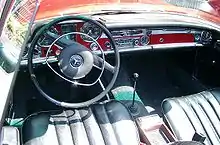
_roadster_(2011-10-31)_02.jpg.webp)
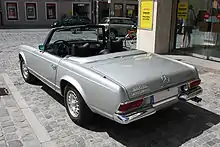
The 280 SL was introduced in December 1967 and continued in production through 23 February 1971, when the W 113 was replaced by the entirely new and substantially heavier R107 350 SL. Over the years, the W 113 evolved from a sports car into a comfortable grand tourer, and US models were by then usually equipped with the 4-speed automatic transmission and air conditioning. Manual transmission models came with the standard 4-speed or the optional ZF 5-speed, which was ordered only 882 times and thus is a highly sought-after original option today. In Europe, manual transmissions without air conditioning were still the predominant choice. Of the 23,885 280 SLs produced, more than half were sold in the US.
The main change was an upgrade to the 2,778 cc (2.8 L) M130 engine with 170 PS (125 kW; 168 hp) maximum power and 180 lb⋅ft (244 N⋅m) maximum torque, which finally gave the W 113 adequate power. The performance improvement was achieved by increasing bore by 4.5 mm (0.2 in), which stretched the limits of the M180 block, and required pairwise cylinder casts without cooling water passages. This mandated an oil-cooler, which was fitted vertically next to the radiator. Each engine was now bench-tested for two hours prior to being fitted, so their power specification was guaranteed at last.[9]
The M130 marked the final evolution of Mercedes-Benz' venerable SOHC M180 inline-six, before it was superseded by the entirely new DOHC M110 inline-six introduced with R107 1974 European 280 SL models. For some time, it was also used in the W 109 300 S-Class, where it retired the expensive 3 liter M189 alloy inline-six.
A brief chronology of the most notable changes made to the 280SL:[8]
- 12/1967: One piece wheel-covers (like W 108/W 109 sedans).
- 10/1968: US models with sealed beam headlights without fog lights.[11]
- 02/1969: New tail lights with amber turn signals.[12]
- 05/1969: ZF 5-speed manual transmission discontinued as listed option and available only on special request.
- 07/1969: US models with headlight assembly with full amber lower section, illuminated side markers, transistorized ignition, and improved emission control.
- 08/1969: Heated rear window for hardtop, hazard lights for all models, single master key for all locks.
- 04/1970: Bosch Lichteinheit headlights optionally with halogen main beam (distinguished by "flat" instead of "bubble" lens).[13]
- 08/1970: Fuchs alloy wheels available as a factory-fitted option.[14]
- 11/1970: Opaque beige plastic coolant expansion tank (instead of satin-black paint over brass). New door locks: cylinder can be depressed while door is locked.
North American models
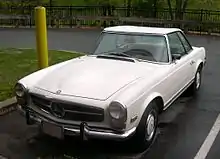
North American models have a number of subtle differences, the most obvious one being the distinctive "sealed beam" bulb headlights required in the US versus the Bosch Lichteinheit headlights for the rest of the world.[11] 1970 US models also acquired amber turn-signal lenses on the rear lights, later than most other countries.[12]
Other differences of the North American models include imperial gauges, chrome bumper guards, side reflectors (illuminated from 1970), lower rear-axle ratios for faster acceleration yet lower top speeds, and no "single-side" parking lights. US market 280 SL engines required emission control modifications, including "softer" valve timings, a reduced compression ratio and a modified injection pump, which reduced power from 170 PS (125 kW; 168 hp) to 160 PS (118 kW; 158 hp).[7] In the US, automatic transmission, air conditioning, and white wall tires were much more popular than elsewhere.
European cars were popular as US gray-market imports: those vehicles were brought to the US some years after their original delivery in Europe. Early European imports had aftermarket hazard lights and Kangol seat belts fitted, US safety requirements that were adopted in Europe only in later production years.
Pininfarina Coupe
While the original design by Paul Bracq is regarded as a masterpiece today, it was more controversial at the time of its introduction. So in 1963, Pininfarina asked the Mercedes-Benz board to produce its own custom-bodied version of the 230 SL. Pininfarina's Tom Tjaarda turned the roadster into a fixed-head coupe that vaguely resembled the Ferrari 250 GT Lusso. He retained the grille and headlamps of the original, but raked the grille more sharply, sculpted the wings, and made the sides more bulbous and thus wider, while making the bonnet narrower and shorter. The rear was reminiscent of the Ferrari 330 GT 2+2 (also a Tjaarda design), but without taking away the distinctive personality of the 230 SL.[15] Inside, Tjaarda left the dashboard unchanged, but the interior as a whole exuded the stamp of elegant Italian hand craftmanship. The result was appealing but not convincing enough to go into production and remained a one-off, subsequently acquired by German press baron Axel Springer.
W 113/12
Mercedes-Benz Chief Engineer Rudolf Uhlenhaut liked pushing the power envelope of his cars. In 1965, he fitted a 250 SL with the massive 6,332 cc (6.3 L) 250 PS (184 kW; 247 hp) M100 V8 engine from the Mercedes-Benz 600. This engine conversion gave the car, denoted as W 113/12, impressive power, but made it very front-heavy, so that this direction was abandoned. The car was eventually destroyed, the usual procedure for test vehicles at the time.[8]
Frua Shooting Brake
In 1966, the Turin coachbuilder Pietro Frua, a prominent car designer in Italy in the 1960s, presented a coach built 230 SLX Shooting Brake version of the 230 SL.[16]
R 113 W 33-29
In 1968, Mercedes-Benz fitted a 280 SL with a 206 PS (152 kW; 203 hp) M50F Wankel engine, denoted as R 113 W 33-29. With a top-speed of 205.1 km/h (127.4 mph), a 0-60 mph (97 km/h) acceleration time of 8.7 seconds, and almost inaudible compared to regular SLs, it provided quite a surprise encounter for their owners in southern Germany at the time.[8]
Timeline
The model timeline and production numbers are:[8][17]
| Chassis | Engine | 1963 | 1964 | 1965 | 1966 | 1967 | 1968 | 1969 | 1970 | 1971 | Total | US | |||
|---|---|---|---|---|---|---|---|---|---|---|---|---|---|---|---|
| 230 SL | W113.042 | 2.3L M127.II I6 | 1,465 | 6,911 | 6,325 | 4,945 | 185 | 19,831 | 4,752 | ||||||
| 250 SL | W113.043 | 2.5L M129.II I6 | 17 | 5,177 | 2 | 5,196 | 1,761 | ||||||||
| 280 SL | W113.044 | 2.8L M130 I6 | 143 | 6,930 | 8,047 | 7,935 | 830 | 23,885 | 12,927 | ||||||
| 48,912 | 19,440 | ||||||||||||||
Motorsports
Spa-Sofia-Liège Rally
In 1963, Eugen Böhringer won the 6,600-kilometre Spa-Sofia-Liège Rally (Belgium to Bulgaria) on a race-modified 1963 230 SL.[8][18] This vehicle is now in the permanent collection of the Mercedes-Benz Museum in Stuttgart Untertürkheim, Germany. On 14 September 1963, Dutch Grand Prix racer Carel Godin de Beaufort took second place in class in the Vaals hill climb in a stock 230SL.
In 1964, Mercedes-Benz entered four race-modified 230 SLs into the Spa-Sofia-Liège Ralley. These cars had special 2.6 liter engines with pairwise cylinder casts, a layout that was later adopted for the M130 engine of the 280 SL. Due to considerable mechanical bad luck, Eugen Böhringer finished only third this time, after Rauno Aaltonen on Austin-Healey 3000 and Erik Carlsson on Saab.[8]
Acropolis Rally
In 1965, Dieter Glemser entered the Acropolis Rally on a light-weight 230 SL similar to the Spa-Sofia-Liège cars. His tuned 2.3 liter engine produced 152 PS (112 kW; 150 hp), further evidence to the fact that 230 SL production engines rarely met their power specification. Unfortunately, Glemser was given wrong directions by the police, costing him his comfortable lead and relegating him to third place.[8]
In media
Magazines
- The Belgian webzine Gentlemen's Corner listed the W 113 among its 20 "Most stylish cars of the past 50 years".[19]
- GQ listed the W 113 among the "Ten cars that made Mercedes-Benz".[20]
- David Gandy of Vogue.com listed the W 113 as one of his "15 favorite cars".[21]
- The Daily Telegraph put the W 113 on its list of "The 100 most beautiful cars" of all time.[22]
Top Gear
On the British automotive TV show Top Gear (Season 3, Episode 8) the 280 SL is thought of highly, notably being described by its host Jeremy Clarkson as one of the cars from the 1960s that has stood the test of time, being "from a time when Mercedes was still building its cars properly."[23]
Technical data
| Mercedes-Benz | 230 SL | 250 SL | 280 SL |
|---|---|---|---|
| Produced: | 1963–1967 | 1966–1968 | 1967–1971 |
| Chassis code: | W113.042 | W113.043 | W113.044 |
| Engine: | 6-cylinder-inline engine (four-stroke), front-mounted | ||
| Engine code: | M 127.II | M 129.II | M 130 |
| Bore x Stroke: | 82 mm (3.2 in) x 72.8 mm (2.9 in) | 82 mm (3.2 in) x 78.8 mm (3.1 in) | 86.5 mm (3.4 in) x 78.8 mm (3.1 in) |
| Displacement: | 2308 cc | 2496 cc | 2778 cc |
| Max. Power @ rpm: | 150 PS (110 kW; 148 hp) @ 5500 | 150 PS (110 kW; 148 hp) @ 5500 | 170 PS (125 kW; 168 hp) @ 5750 |
| Max. Torque @ rpm: | 196 N⋅m (145 lb⋅ft) @ 4200 | 216 N⋅m (159 lb⋅ft) @ 4200 | 240 N⋅m (177 lb⋅ft) @ 4500 |
| Compression Ratio: | 9.3: 1 | 9.5: 1 | 9.5: 1 |
| Fuel feed: | Multi-port fuel injection, Bosch mechanical injection pump | ||
| Fuel tank capacity: | 65 L (17.2 US gal; 14.3 imp gal) | 82 L (21.7 US gal; 18.0 imp gal) | |
| Valvetrain: | SOHC, single roller chain | SOHC, duplex chain | |
| Cooling: | Water | ||
| Gearbox: | 4-speed manual, 4-speed automatic or 5-speed manual rear wheel drive, standard axle ratio 3.75:1 (on request 3.69:1 or 3.92:1) | ||
| Electrical system: | 12 volt | ||
| Front suspension: | Double wishbones, coil springs, stabilising bar | ||
| Rear suspension:: | Swing axle, radius arms, compensating spring, coil springs | ||
| Brakes: | Disc/Drum brakes (Ø 253 mm (10.0 in) front, 230 mm (9.1 in) rear), power assisted | Disc brakes all around (Ø 273 mm (10.7 in) front, 279 mm (11.0 in) rear), power assisted | |
| Steering: | Recirculating ball steering, on request power-assisted | ||
| Body structure: | Sheet steel, monocoque (unibody) construction | ||
| Dry weight: | 1,300 kg (2,900 lb) (hardtop + 49 kg (108 lb)) | 1,360 kg (3,000 lb) (hardtop + 49 kg (108 lb)) | |
| Loaded weight: | 1,650 kg (3,640 lb) | 1,715 kg (3,781 lb) | |
| Track front/ rear: | 1,485 mm (58.5 in) 1,485 mm (58.5 in) | ||
| Wheelbase: | 2,400 mm (94 in) | ||
| Length: | 4,285 mm (168.7 in) | ||
| Width: | 1,760 mm (69 in) | ||
| Height: | 1,305 mm (51.4 in) | ||
| Tyre/Tire sizes: | 185 HR 14 | ||
| Top speed: | 200 km/h (120 mph) | 195 km/h (121 mph) | 200 km/h (124 mph) |
| Fuel Consumption (estimate): | 15.0 litres per 100 kilometres (18.8 mpg‑imp; 15.7 mpg‑US) | 16.0 litres per 100 kilometres (17.7 mpg‑imp; 14.7 mpg‑US) | 16.5 litres per 100 kilometres (17.1 mpg‑imp; 14.3 mpg‑US) |
| Price Germany USA: | 22,200 DM $7,506−$7,907, later $6,185−$6,587[24] | 22,800 DM $6,485−$6,897 | 24,300 DM $6,485−$6,897, later $7,469−$7,909 |
Famous owners
- Charlton Heston[20]
- David Coulthard owns a midnight blue (904G) 1971 280 SL
- Tony Curtis[20]
- John Lennon owned a dark blue (332G) 1965 230 SL,[20] which was for sale for $495,000 in 2011[25]
- John Travolta owns a havana brown (408G) 1970 280 SL,[26] which was stolen in September 2011[27]
- Kate Moss owns a metallic blue (387H) 280 SL[28]
- Nico Rosberg[29]
- Peter Ustinov[20]
- Sophia Loren[20]
- Stirling Moss[30]
- Colin Powell[31]
- Priscilla Presley - A gift from her then-husband, Elvis Presley, the 1969 white convertible 280SL is at Graceland as a permanent display.
- John Gutfreund
In popular culture
- In 2016 Bollywood film Fitoor, Aditya Roy Kapoor's character drives a red 280SL
- In the 2011 French gangster film A Gang Story, François Levantal's character drives a sandy beige 280 SL.
- In the 2011 British espionage film Tinker, Tailor, Soldier, Spy, a dark early 280 SL is driven along unspecified docks.
- In the 2008 German film The Baader Meinhof Complex, a white 230 SL is parked in the driveway of Martina Gedeck character's house.
- In the 2008 television drama Mad Men, Season 2: Episode 11 "The Jet Set", Jon Hamm's character is given a ride to Palm Springs in a white late model 280 SL. As the episode takes place in 1962, the 280 SL is an anachronism.
- In the 2008 film Frost/Nixon Michael Sheen's character drives a grey blue 280 SL in the closing scenes.
- In the 2002 film Life or Something Like It Angelina Jolie's character drives a silver 1969 280 SL with red interior and alloy rims.
- In the 1997 German film Knockin' on Heaven's Door Til Schweiger's and Jan Josef Liefers's terminally ill characters steal a horizon blue 230 SL to see the ocean for the first and last time.
- In the 1994 melodrama Intersection Richard Gere's character flashes through key memories of his life during a fatal accident in his silver 280 SL.
- In the 1982 music video for Juice Newton's single Love's Been A Little Bit Hard On Me, a black 280 SL is featured prominently.
- In the 1981-1987 police series Hill Street Blues counselor Joyce Davenport (Veronica Hamel) drives a dark W113
- In the 1980 British gangster epos The Long Good Friday Bryan Marshall's character drives a signal red 280 SL.
- In the 1980 movie “Hopscotch” with Walter Matthau and Glenda Jackson, directed by Ronald Neame, Miles Kendig’s old colleague and lover in Salzburg, Isabelle von Schönenberg (Glenda Jackson), drives a signal red Mercedes Benz 280SL around the streets of Salzburg, Austria.
In the 1979 film "Breaking Away" Car is driven by character Rod (Hart Bochner) from University of Indiana.
- In the 1975 Indian movie Dharmatma Feroz Khan drives the car in a chase sequence.
- In the 1975 film Shampoo starring Warren Beatty, Julie Christie's character drives a bicolour (white with black hardtop/hubcaps) 230 SL.
- In the 1974 Czechoslovakian comedy How to Drown Dr. Mracek, the Lawyer
- In the 1974 thriller Gold starring Roger Moore, Susannah York's character drives a white early 280 SL.
- In the 1967 melodrama Two for the Road starring Audrey Hepburn, Albert Finney's character drives a white 1965 230 SL. In reality, this was Stanley Donen's (the director) personal car.
- In the 1967 French musical The Young Girls of Rochefort starring Catherine Deneuve and Gene Kelly, George Chakiris' character owns and drives a white 230 SL.
- In the 1966 John Frankenheimer racing film “Grand Prix”, a dark green MB 230SL is visible parked behind the figure of Agostini Manotti (a surrogate name for Enzo Ferrari, played by Adolfo Celi) during his argument with the racing driver J.P. Sarti (Yves Montand).
- In the 1966 thriller Arabesque starring Gregory Peck, Sophia Loren's character drives a red 1965 230 SL.
- In the 1965 drama Darling, Julie Christie's character drives a white 230 SL, owned by Laurence Harvey's character, through London at dawn.
See also
References
- Oswald, Werner (2001). Deutsche Autos 1945-1990, Band 4. Stuttgart: Motorbuch Verlag. ISBN 978-3-613-02131-0.
- US patent 3169793, Béla Barényi & Paul Bracq, "Motor vehicle with a concave top", issued 1965-02-16, assigned to Daimler-Benz Aktiengesellschaft
- "1955-1963 Mercedes-Benz 190 SL". auto.howstuffworks.com. 18 September 2007.
- "Star of Geneva". www.mercedesheritage.com. Archived from the original on 28 December 2010. Retrieved 11 February 2011.
- "W113-280SL-Fahrwerk". Mercedes-Benz Classic Wiki. Archived from the original on 9 April 2011.
- "Mercedes-Benz 230SL". sportscars.tv.
- Laurence, Meredith (1996). The Original Mercedes SL. Heel Verlag. ISBN 978-3-89365-540-3.
- Engelen, Günter (1991). Mercedes-Benz 190SL-280SL. Motorbuch Verlag. ISBN 978-3-613-01367-4.
- Long, Brian (2011). Mercedes-Benz SL W113 Series. Veloce. ISBN 978-1-84584-304-5.
- "New Mercedes benz 250 SL released Geneva". Autocar. Vol. 126 (nbr 3706). 9 March 1967. p. 32.
- "US Light Assembly". www.sl113.org.
- "Tail lights". www.sl113.org.
- "European Headlight Assembly". www.sl113.org.
- "Alloy Wheels". www.sl113.org.
- "The Pininfarina 230 SL". mercedesheritage.com. 6 November 2009.
- "Mercedes-Benz 230 SLX Shooting brake". pietro-frua.de. 2010.
- Rohde, Michael; Koch, Detlev (2000). Typenkompass Mercedes-Benz. Stuttgart: Motorbuch Verlag. pp. 79, 80, 81. ISBN 978-3-613-02019-1.
- Patrick C. Paternie (8 September 2010). "Fast Classics: Mercedes-Benz 230 SL and 300SE Rally Cars". wheellifeadventures.com. Archived from the original on 18 July 2011.
- "Most stylish cars of the past 50 years". Belgium: Gentlemen's Corner. 25 January 2012. Retrieved 4 March 2012.
- Jason Barlow (July 2011). "Ten cars that made Mercedes-Benz". GQ. U.S. Archived from the original on 6 June 2012. Retrieved 18 September 2011.
- David Gandy (January 2011). "15 favourite cars". U.S.: Vogue.com. Archived from the original on 2 September 2012. Retrieved 18 September 2011.
- "The 100 most beautiful cars". The Daily Telegraph. U.K. March 2008. Retrieved 18 September 2011.
- Jeremy Clarkson (21 December 2003). "Top Gear - 280 SL". BBC. Archived from the original on 25 September 2011.
- US prices: Mike Covello: Standard Catalog of Imported Cars 1946-2002, Krause Publication, Iola 2002, ISBN 0-87341-605-8, p. 533-536
- "1965 Mercedes-Benz 230 SL Roadster". vintagemotorssarasota.com. February 2011. Archived from the original on 2 April 2011.
- Mihnea Radu (February 2011). "John Travolta Spotted in His 1965 Mercedes 230 SL Roadster". autoevolution.com.
- Josh Grossberg (September 2011). "John Travolta's vintage Mercedes stolen". msnbc.com. Archived from the original on 23 September 2011.
- Clarencia Cynrae (March 2008). "Kate Moss in her classic Mercedes SL in 2002". celebgalz.com.
- "Nico Rosberg".
- Engelen, Günter (2008). Heidbrink, Gerhard (ed.). Faszination SL (230 SL - 280 SL) [Fascination SL] (2nd ed.). Stuttgart: Mercedes-Benz Classic Archives. ISBN 978-3-613-02869-2.
- http://capitolfile-magazine.com/colin-powell-favorite-cars
External links
| Wikimedia Commons has media related to Mercedes-Benz W113. |
- Curbside Classic: 1963 Mercedes-Benz 230SL – Big Shoes To Fill – a retrospective of the W113
- Bollywood's Love for Car's